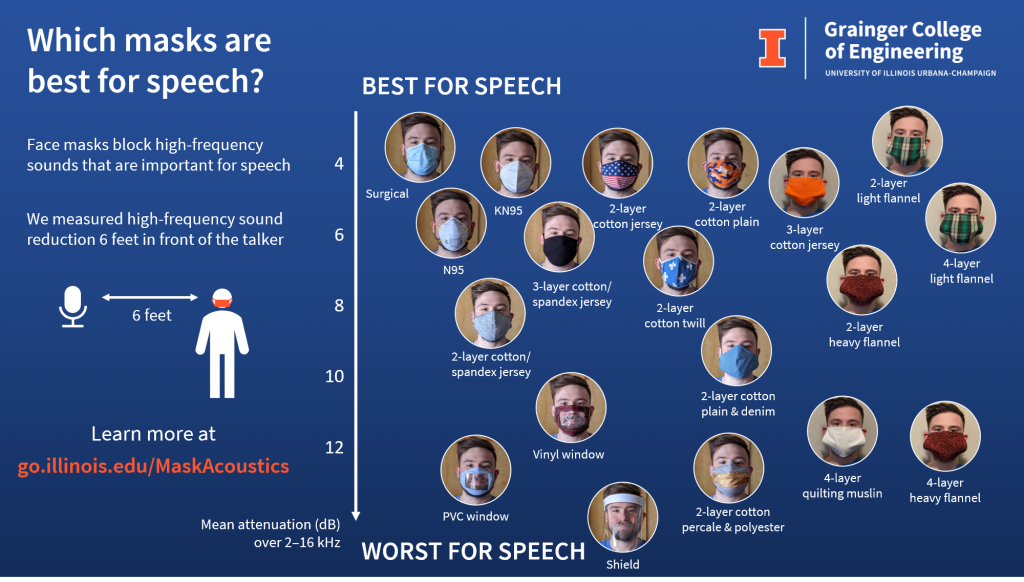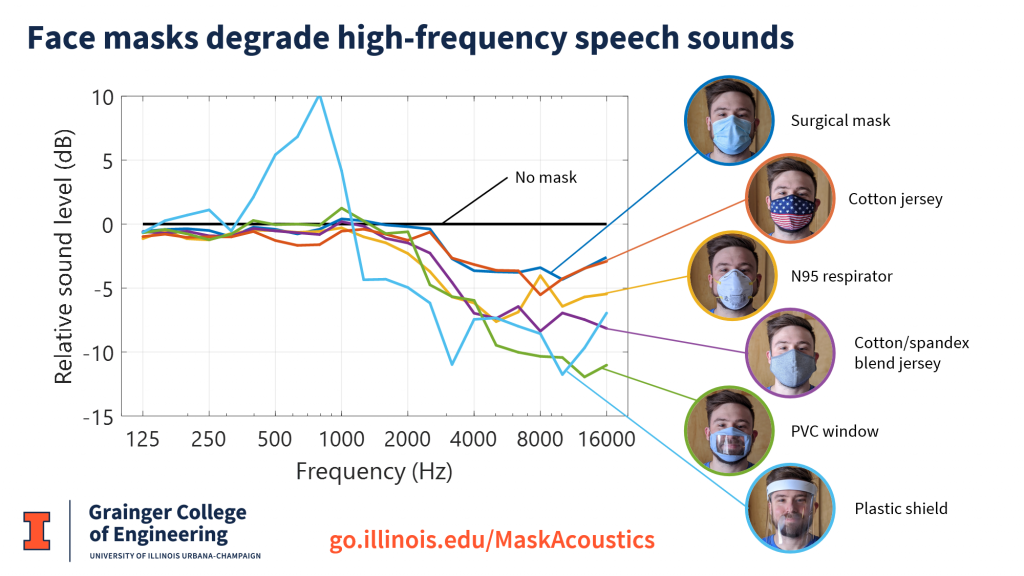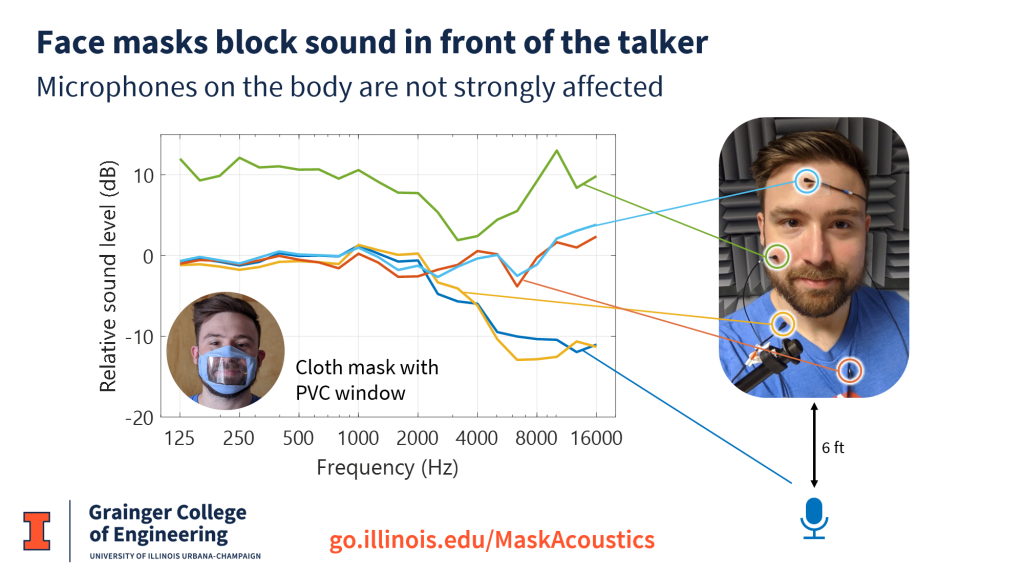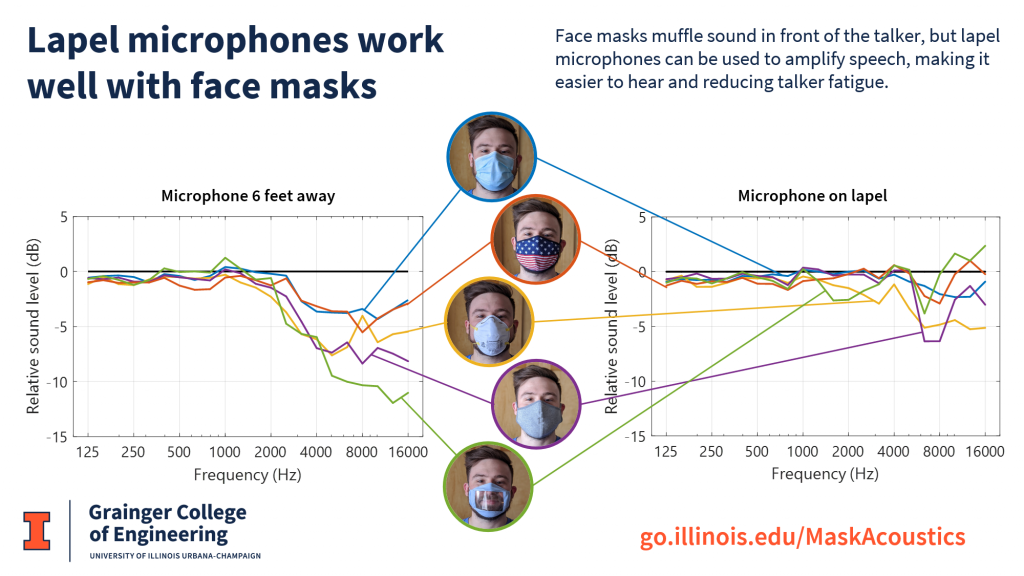This post describes our recent paper “Acoustic effects of medical, cloth, and transparent face masks on speech signals” in The Journal of the Acoustical Society of America. This work was also discussed in The Hearing Journal and presented at the 179th Acoustical Society of America meeting.
Face masks are a critical tool in slowing the spread of COVID-19, but they also make communication more difficult, especially for people with hearing loss. Face masks muffle high-frequency speech sounds and block visual cues. Masks may be especially frustrating for teachers, who will be expected to wear them while teaching in person this fall. Fortunately, not all masks affect sound in the same way, and some masks are better than others. Our research team measured several face masks in the Illinois Augmented Listening Laboratory to find out which are the best for sound transmission, and to see whether amplification technology can help.
Several months into the pandemic, we now have access to a wide variety of face masks, including disposable medical masks and washable cloth masks in different shapes and fabrics. A recent trend is cloth masks with clear windows, which let listeners see the talker’s lips and facial expressions. In this study, we tested a surgical mask, N95 and KN95 respirators, several types of opaque cloth mask, two cloth masks with clear windows, and a plastic face shield.
We measured the masks in two ways. First, we used a head-shaped loudspeaker designed by recent Industrial Design graduate Uriah Jones to measure sound transmission through the masks. A microphone was placed at head height about six feet away, to simulate a “social-distancing” listener. The loudspeaker was rotated on a turntable to measure the directional effects of the mask. Second, we recorded a human talker wearing each mask, which provides more realistic but less consistent data. The human talker wore extra microphones on his lapel, cheek, forehead, and in front of his mouth to test the effects of masks on sound capture systems.
The best and worst face masks for speech
All masks tested attenuated high-frequency sounds above 1 kHz, with the worst attenuation above 4 kHz. These high-frequency signals are important for hearing sounds like “s,” “f,” and “th,” which are usually the most challenging sounds for people with hearing loss. The performance of the masks appears to depend mostly on material and weave, rather than thickness.
The best masks overall were the surgical mask, which is made of nonwoven polypropylene fibers, and the KN95 respirator. They were followed closely by the lightest cloth masks, which were made of 100% cotton with plain and jersey weaves.
The N95 respirator, which is made of thick nonwoven material and fits tightly on the face, blocked more sound than the surgical mask and KN95 respirator. The cloth face masks made of a cotton/spandex blend – similar to underwear – absorbed more sound than the loosely woven 100% cotton masks. Surprisingly, the flat three-layer cotton/spandex mask affected the sound less than the more form-fitting two-layer cotton/spandex mask, suggesting that the number of layers is less important than the material and fit of a mask. The worst cloth masks for sound transmission were those made of denim and bedsheets, which are both tightly woven cotton fabrics.
December 2020 update: We recently tested new cloth masks made of plain-weave cotton, loosely woven flannel, and densely woven flannel in different numbers of layers, all sewn by Catherine Somers from the Electrical and Computer Engineering office. The results show that masks with more layers do block more sound, but the weave seems to be more important. Notably, the 2-layer heavy flannel mask blocked more sound than the 4-layer light flannel mask.
Because people with hearing loss often rely on visual cues such as lip movements more than people with normal hearing do, some hearing loss advocates have suggested using masks with clear windows instead of opaque cloth masks. Unfortunately, our experiments show that clear masks strongly degrade high-frequency sounds. Listeners with hearing loss are therefore forced to choose between sound cues and visual cues.
Sound reinforcement and assistive listening systems can help
Fortunately, there is a way to preserve both visual cues and high-frequency sounds. Our data suggest that masks, especially plastic windows and shields, deflect sound to the side of the face. While sound is muffled in front of the talker, it is unchanged or even amplified in other directions. Thus, a talker with a clear mask could wear a microphone to help amplify high-frequency sounds.
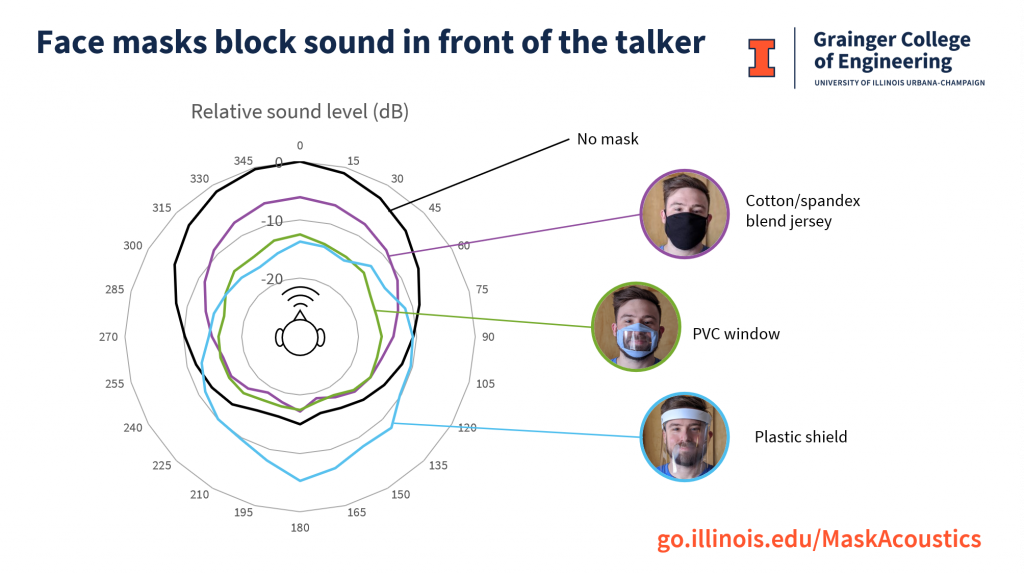
Masks have the strongest attenuation in front of the talker. The plastic shield reflects sound behind the talker. These plots were generated by placing the head-shaped speaker on a rotating turntable.
We tested four commonly used microphone positions: to the side of the mouth (like a headset), on the cheek, on the forehead, and on the lapel a few inches below the chin. The sound at the headset microphone was not very different from that at the distant listener. The cheek microphone was covered by the mask, so sound was amplified but also distorted. The lapel and forehead microphones, however, were mostly unaffected by most of the masks.
Lapel microphones are already widely used for amplification systems in classrooms and auditoriums, and some hearing aid users have remote microphones that clip to the chest. These systems should work well with face masks, including masks with clear windows, with no special modifications required. Amplification systems can help people hear and also reduce fatigue for the talker, which will be especially important for teachers dealing with what is already a stressful situation.
Takeaways
This research showed that more breathable masks, such as surgical masks and plain-weave cotton, transmit sound better than plastic windows and densely woven fabrics. It is important to note that we did not evaluate how effective the masks are at blocking droplet transmission; it is possible that the most effective masks against the virus are the least effective for sound, and vice versa. Fortunately, all masks seem to work well with lapel microphones, which could benefit teachers and others who will need to be heard while wearing a face mask.


